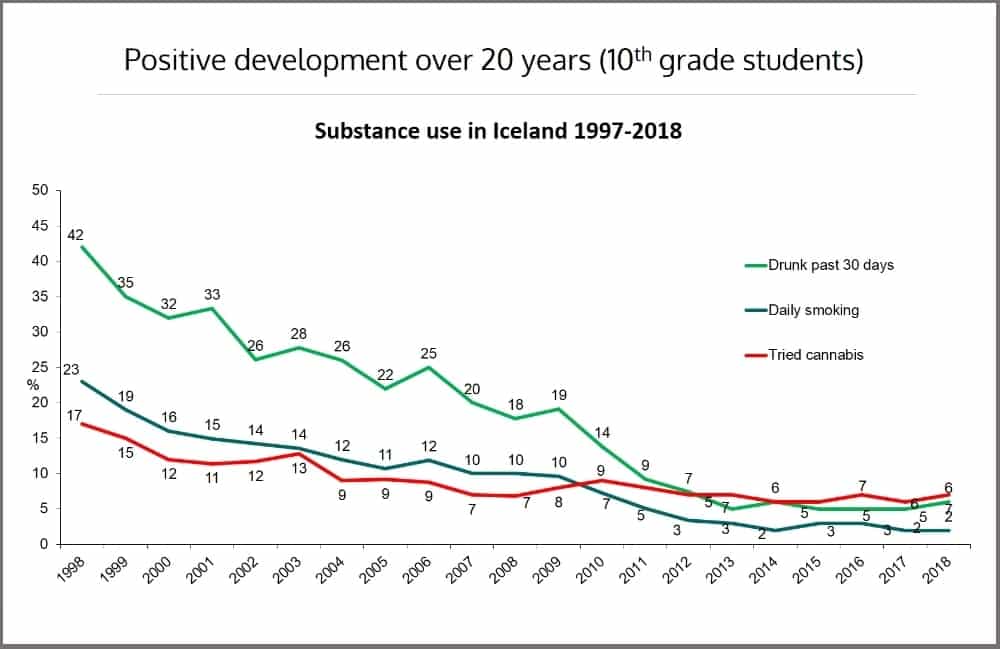What can Iceland teach us about substance abuse prevention? In 2017, the headlines came out of Iceland and swept through the prevention community. A radical, seismic, change had occurred.
They’d discovered a proven way to reduce the number of teenagers engaging in risky, dangerous, and life-altering behaviors with substance use.
15 years prior to this, Iceland had one of the worst youth drug and alcohol abuse rates in the world. The streets of Reykjavik were overrun with drunk and stoned kids. It was a mess.
But as these headlines reported, Iceland over the last two decades has somehow gone from the highest drug and alcohol abuse rate in Europe to the lowest.
When the news first hit the headlines we had to know — How’d they do that?
Here’s how.
An American named Dr. Harvey Milkman came along to help Iceland orchestrate a national prevention campaign centered around the concept of Natural Highs. Instead of investing time and money in a scared-straight approach or education about the harmful side effects, they took an upside-down approach and invested in the passions and interests of kids. The results were shocking.
Over 20 years alcohol abuse rates among teens drastically decreased from 42% to 6%.

Some called this countrywide revolution the single most significant social milestone in drug and alcohol prevention ever.
As counterintuitive as it sounds, we know it makes perfect sense — it’s the basis for our prevention program, too.
No group of teenagers throughout the course of history have responded well to threats, fear, or warnings.
But, if you come alongside them, listen to them, and encourage them to double down on what makes them come alive — that’s where the transformation occurs.
Much of this wildly successful social experiment centered on kids finding their Natural High.
So, that got our attention. We wanted to pick this experiment apart and find out what made it work.
We’re passing these valuable learnings on to you because there’s a lot here that can help equip parents and teachers in their work to help youth thrive. We wholeheartedly believe that inspiring kids with an aspirational vision for their lives is more impactful than trying to scare them into making healthy choices. In our twenty-five year history, we’ve seen that time and again.
There were 3 basic factors that contributed to the Iceland program’s success:
- Facilitate Students Finding their Natural High — Dr. Harvey Milkman researched the chemistry of behavioral addiction for years before concluding that substituting a natural high for drug and alcohol abuse wasn’t just a nice idea — it could work. As he said: “We didn’t say to them, you’re coming in for treatment. We said, ‘we’ll teach you anything you want to learn: music, dance, hip hop, art, martial arts.’ These distinct classes could provide a variety of alterations in the kids’ brain chemistry, and give them what they needed to cope better with life.”
- Cultivating Life Skills — Schools supported Milkman’s vision and the government allocated increased funding for youth activities that taught young people valuable life skills as they pursued their natural highs. This is why we talk at Natural High about the principles that create protective factors for youth. Finding the natural high is the first. We also have to encourage strong mentor relationships, positive peer influence, belief in oneself, the ability to set goals, and resilience.
- Building Guardrails — Iceland recognized that young people would only change in an environment conducive to change. This meant that laws had to be strengthened, teen curfew had to be initiated, and perhaps most importantly, the environment at home had to change. Parents agreed to a commitment that they would work to postpone their child’s first drink until the age of 18, spend more time with their teenagers, get to know their teen’s friends, and not let them have unsupervised parties. As we know well at Natural High, simply delaying a child’s first drink can make all the difference!
In the end, Milkman offered a three-part recipe for American adults seeking to help curb youth drug abuse:
- Help them find their natural high. Invest in their interests and enroll them in activities.
- Spend more time at home together as a family.
- Get to know your teen’s friends.
For more info on this groundbreaking study, read here. And let’s put some of these simple principles to work in our own homes and schools!


